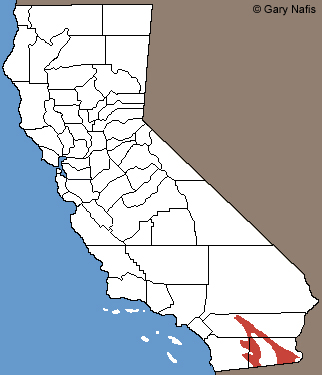|
 |
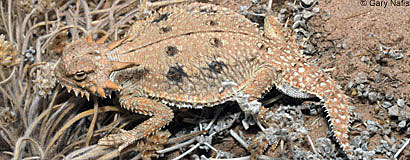 |
| Adult, Imperial County |
Adult, Imperial County |
 |
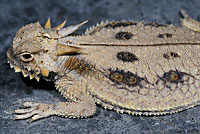 |
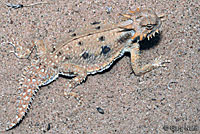 |
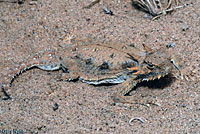 |
| Adult aprox. 20 ft. below Sea Level, Imperial County |
Adult, Imperial County |
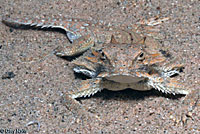 |
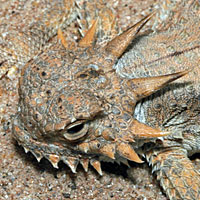 |
 |
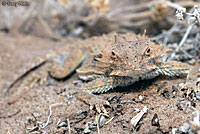 |
| Adult, Imperial County |
 |
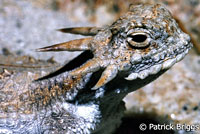 |
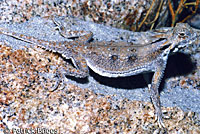 |
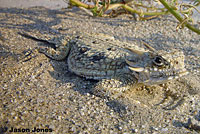 |
| Adult, Imperial County © Patrick Briggs |
Adult, Imperial County
© Patrick Briggs |
Adult female, Imperial County
© Patrick Briggs |
Adult, San Diego County
© Jason Jones |
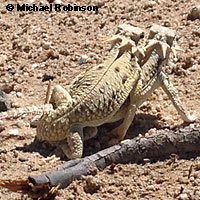 |
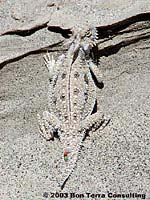 |
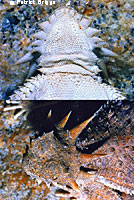 |
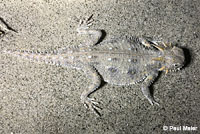 |
Adults breeding in Imperial County
© Michael Robinson |
Adult, Riverside County
(note researcher's tracking tag on tail)
© 2003 Bon Terra Consulting.
|
Adult head study, Imperial County
© Patrick Briggs |
Adult, Imperial County © Paul Maier |
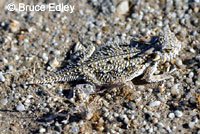 |
 |
 |
|
Juvenile, San Diego County
© Bruce Edley |
Adult, Imperial County © Paul Maier |
Flat-tailed Horned Lizards are covered with small granular scales interspersed with larger pointed scales on the dorsal surfaces. |
|
| |
|
|
|
| Habitat |
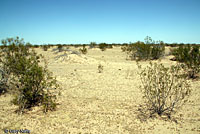 |
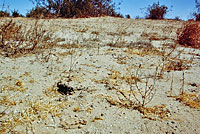 |
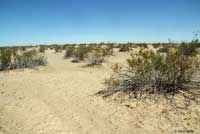 |
 |
Habitat, Imperial County
|
Cryptic adult in habitat,
(in the middle at the bottom)
Imperial County |
Habitat, Imperial County |
Habitat during a wet spring with a good wildflower bloom, Imperial County (same area as the photo to the left.) |
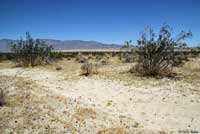 |
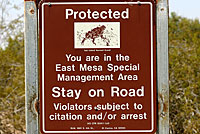 |
|
|
| Habitat, San Diego County |
Sign in Imperial County |
|
|
| |
|
|
|
| Short Video |
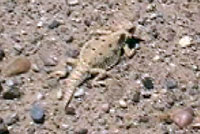 |
|
|
|
| A Flat-tailed Horned Lizard runs rapidly across fine wind-blown sand and quickly buries itself with a final shake of its tail. |
|
|
|
|
| Description |
| |
| Size |
2.2 - 3.4 inches long from snout to vent (6.3 - 8.6 cm). (Stebbins, 2003)
|
| Appearance |
A medium-sized flat-bodied lizard with a wide oval-shaped body and enlarged pointed scales on the upper body and tail.
The tail is long and flattened.
The back skin is smooth with small spines.
8 horns extend from the back of the head.
The two central horns are long, slender and sharp.
Long and narrow spines on the lower jaw and two rows of fringe scales on the sides of the body, the bottom row scales smaller than the upper.
Females are larger in size than males. |
| Color and Pattern |
Color is light gray, tan, brownish, beige, or whitish above, matching the sand and soil.
There is a dark stripe down the middle of the back and usually dark spots running down each side of the stripe.
(This is the only horned lizard with a dark stripe on the back.)
The underside is white with no markings.
|
| Life History and Behavior |
Activity |
Diurnal.
Adapted to hot dry environments.
Can be active in very hot weather.
Able to run very quickly.
Does not squirt blood from eyes in defense like other horned lizards.
Population density is low and individuals have a relatively large home range.
Most adults apparently hibernate in the winter, but juveniles may remain active all year.
Most adults emerge in April, but some have been observed emerging in February and March.
They do not aestivate in Summer, but they will retreat into shallow burrows or rapidly shuffle from side to side to burrow into the sand in order to avoid extreme heat and cold.
Horned lizards roam a home range, which may overlap with others and change seasonally, but male horned lizards do not defend their territory aggressively like other kinds of lizards. They don't have patches of brighly-colored scales to display to other males. Because they don't combat other males during the breeding season, their bodies are smaller than the bodies of female horned lizards, which lets them use their energy in searching for females instead of maintaining a large body size.
(Sherbrooke, 2003) |
| Defense |
When threatened, this lizard is capable of running away very quickly.
It will often stop and quickly bury itself in loose sand to hide, or sometimes it will run under a low bush or into a rodent burrow.
Its main defense is remaining motionless using its cryptic coloring to blend into the background and make it difficult to see. It will crouch down low to prevent shadows that could make it easier to see, and sit still to avoid detection. |
| Diet and Feeding |
Eats mostly ants, especially Harvester ants, and occasionally other small invertebrates.
Although horned lizards may be desirable pets, captive animals normally do not live very long due to the difficulties of feeding them a proper diet of ants. |
| Reproduction |
Mates April to May.
Females lay one or two clutches of 3 - 10 eggs from May to June.
|
| Hybrids |
According to Leache and McGuire (2006) in their paper that described the species Phrynosoma goodei, P. mcallii hybridizes with P. goodei in the Yuma Desert.
|
| Habitat |
Typical habitat is sandy desert hardpan or gravel flats with scattered sparse vegetation of low species diversity. Most common in areas with a high density of harvester ants and fine windblown sand, but rarely occurs on dunes.
|
| Geographical Range |
| The historic range of this lizard is throughout most of the Colorado desert from the Coachella Valley south through the Imperial Valley and west into the Anza-Borrego desert, south to extreme NE Baja California, extreme SW Arizona and NW Sonora, Mexico.
|
 |
| Elevational Range |
From below sea level to around 820 ft. in elevation.
|
| Notes on Taxonomy |
Leache and McGuire (2006, Molecular Phylog. Evolution 39:628-644) named four subclades of Phrynosoma - 3 in our area: Anota, Doliosaurus, and Tapaja.
Alternate and Previous Names (Synonyms)
Commonly called: "Horny Toad," or "Horned Toad"
Phrynosoma mcallii - Flat-tailed Horned Lizard (Stebbins 1985, 2003, 2012, 2018)
Phrynosoma m'calli - Flat-tailed Horned Lizard (Smith 1946, Stebbins 1954, 1966)
Phrynosoma m'callii - Flat-tailed Horned-toad (Doliosaurus mc'calli. Flat-tailed Horned Lizard; McCall's Horned Lizard; MacCall's Horned Toad.) (Grinnell and Camp 1917)
|
| Conservation Issues (Conservation Status) |
"Threatened by a variety of human disturbances within its highly restricted range caused by agricultural, urban, and geothermal developments, extensive off-road vehicle use, sand and gravel mining, and other impacts." (Stebbins, 2003)
Federally protected since 1993, the Federal protection of P. mcallii was withdrawn in 2006.
California wildlife officials voted against putting P. mcallii on the endangered species list in December, 2016. |
|
|
Taxonomy |
| Family |
Phrynosomatidae |
Zebra-tailed, Earless, Fringe-toed, Spiny, Tree, Side-blotched, & Horned Lizards |
Fitzinger, 1843 |
| Genus |
Phrynosoma |
Horned Lizards |
Wiegmann, 1828 |
Species
|
mcallii |
Flat-tailed Horned Lizard |
Hallowell, 1852 |
|
Original Description |
Phrynosoma mcallii - (Hallowell, 1852) Originally spelled "m'callii" - Proc. Acad. Nat. Sci. Philadelphia, Vol. 6, p. 182
from Original Description Citations for the Reptiles and Amphibians of North America © Ellin Beltz
|
|
Meaning of the Scientific Name |
Phrynosoma - Greek - phrynos - toad and soma - body - refers to the squat, toad-like appearance
mcallii - honors Col. George A. M'Call of the U.S. Army who collected the lizard in the 1850's.
from Scientific and Common Names of the Reptiles and Amphibians of North America - Explained © Ellin Beltz
(and Sherbrooke 2003)
|
|
Related or Similar California Lizards |
Phrynosoma platyrhinos calidiarum - Southern Desert Horned Lizard
Phrynosoma platyrhinos platyrhinos - Northern Desert Horned Lizard
Phrynosoma blainvillii - Blainville's Horned Lizard
Phrynosoma douglasii - Pygmy Short-horned Lizard
|
|
More Information and References |
California Department of Fish and Wildlife
Horned Lizard Conservation Society
Hansen, Robert W. and Shedd, Jackson D. California Amphibians and Reptiles. (Princeton Field Guides.) Princeton University Press, 2025.
Stebbins, Robert C., and McGinnis, Samuel M. Field Guide to Amphibians and Reptiles of California: Revised Edition (California Natural History Guides) University of California Press, 2012.
Stebbins, Robert C. California Amphibians and Reptiles. The University of California Press, 1972.
Flaxington, William C. Amphibians and Reptiles of California: Field Observations, Distribution, and Natural History. Fieldnotes Press, Anaheim, California, 2021.
Samuel M. McGinnis and Robert C. Stebbins. Peterson Field Guide to Western Reptiles & Amphibians. 4th Edition. Houghton Mifflin Harcourt Publishing Company, 2018.
Stebbins, Robert C. A Field Guide to Western Reptiles and Amphibians. 3rd Edition. Houghton Mifflin Company, 2003.
Behler, John L., and F. Wayne King. The Audubon Society Field Guide to North American Reptiles and Amphibians. Alfred A. Knopf, 1992.
Powell, Robert., Joseph T. Collins, and Errol D. Hooper Jr. A Key to Amphibians and Reptiles of the Continental United States and Canada. The University Press of Kansas, 1998.
Bartlett, R. D. & Patricia P. Bartlett. Guide and Reference to the Turtles and Lizards of Western North America (North of Mexico) and Hawaii. University Press of Florida, 2009.
Jones, Lawrence, Rob Lovich, editors. Lizards of the American Southwest: A Photographic Field Guide. Rio Nuevo Publishers, 2009.
Smith, Hobart M. Handbook of Lizards, Lizards of the United States and of Canada. Cornell University Press, 1946.
Sherbrooke, Wade C. Horned Lizards, Unique Reptiles of Western North America. Southwest Parks and Monuments Association, 1981.
Sherbrooke, Wade C. Introduction to Horned Lizards of North America. University of California Press, 2003.
Lemm, Jeffrey. Field Guide to Amphibians and Reptiles of the San Diego Region (California Natural History Guides). University of California Press, 2006.
Grismer, L. Lee. Amphibians and Reptiles of Baja California, Including Its Pacific Islands and the Islands in the Sea of Cortés. The University of California Press, 2002.
Adam D. Leache, Jimmy A. McGuire. Phylogenetic relationships of horned lizards (Phrynosoma) based on nuclear and mitochondrial data: Evidence for a misleading mitochondrial gene tree. Molecular Phylogenetics and Evolution 39 (2006) 628–644.
Joseph Grinnell and Charles Lewis Camp. A Distributional List of the Amphibians and Reptiles of California. University of California Publications in Zoology Vol. 17, No. 10, pp. 127-208. July 11, 1917.
|
|
|
The following conservation status listings for this animal are taken from the April 2024 State of California Special Animals List and the April 2024 Federally Listed Endangered and Threatened Animals of California list (unless indicated otherwise below.) Both lists are produced by multiple agencies every year, and sometimes more than once per year, so the conservation status listing information found below might not be from the most recent lists. To make sure you are seeing the most recent listings, go to this California Department of Fish and Wildlife web page where you can search for and download both lists:
https://www.wildlife.ca.gov/Data/CNDDB/Plants-and-Animals.
A detailed explanation of the meaning of the status listing symbols can be found at the beginning of the two lists. For quick reference, I have included them on my Special Status Information page.
If no status is listed here, the animal is not included on either list. This most likely indicates that there are no serious conservation concerns for the animal. To find out more about an animal's status you can also go to the NatureServe and IUCN websites to check their rankings.
Check the current California Department of Fish and Wildlife sport fishing regulations to find out if this animal can be legally pursued and handled or collected with possession of a current fishing license. You can also look at the summary of the sport fishing regulations as they apply only to reptiles and amphibians that has been made for this website.
P. mcallii was formerly listed as FPT - Federally proposed for listing as Threatened - but this was withdrawn 3/5/11.
|
| Organization |
Status Listing |
Notes |
| NatureServe Global Ranking |
G3 |
Vulnerable
|
| NatureServe State Ranking |
S3 |
Vulnerable
|
| U.S. Endangered Species Act (ESA) |
None |
|
| California Endangered Species Act (CESA) |
None |
|
| California Department of Fish and Wildlife |
SSC |
Species of Special Concern |
| Bureau of Land Management |
S |
Sensitive |
| USDA Forest Service |
None |
|
| IUCN |
NT |
Near Threatened |
|
|





























